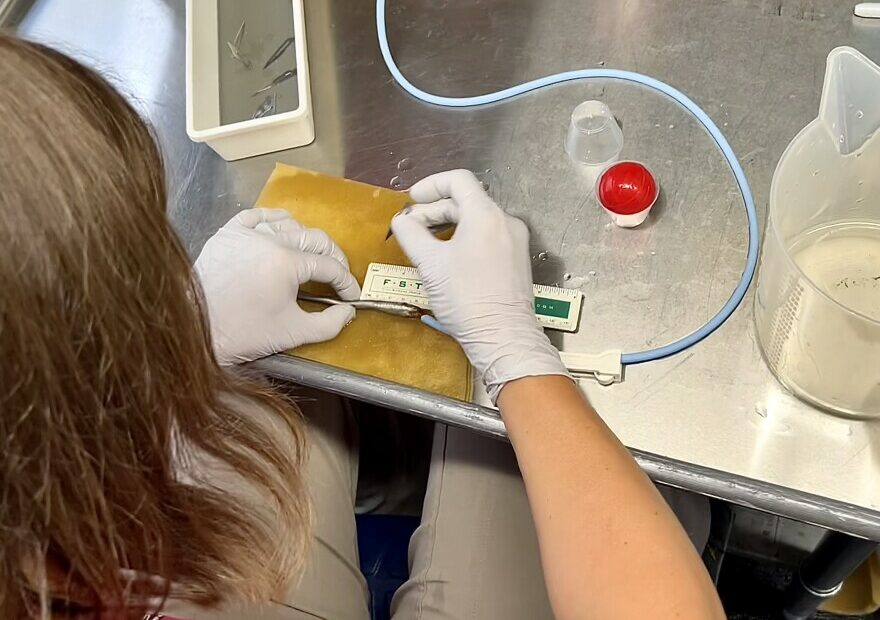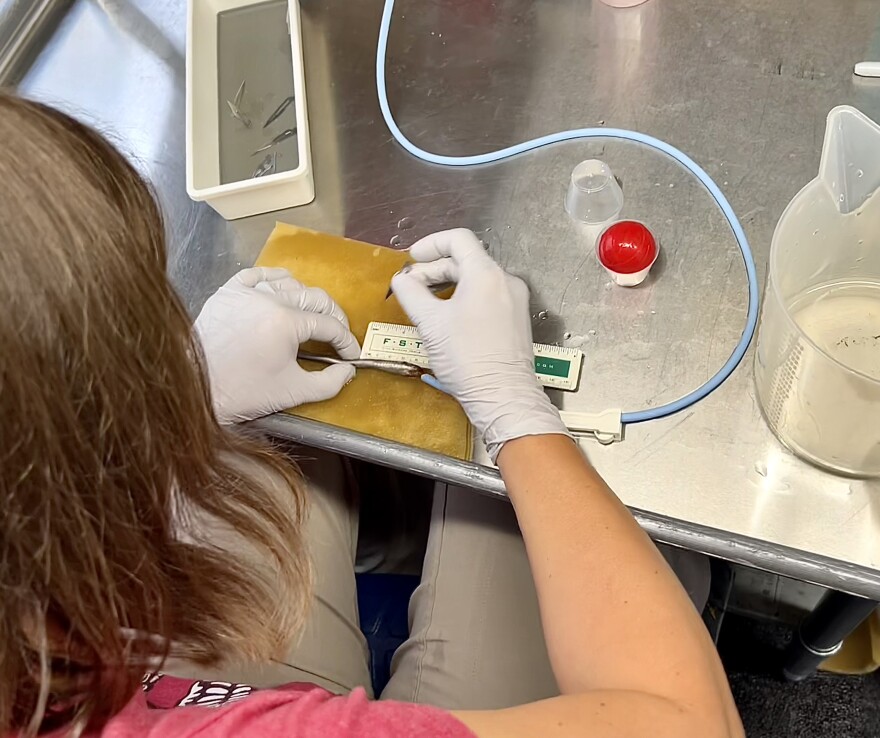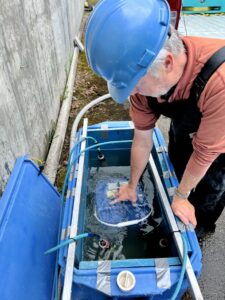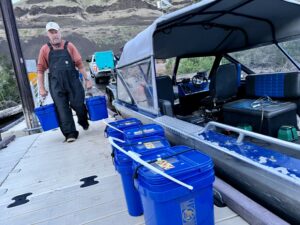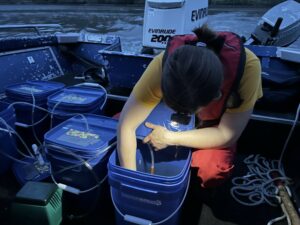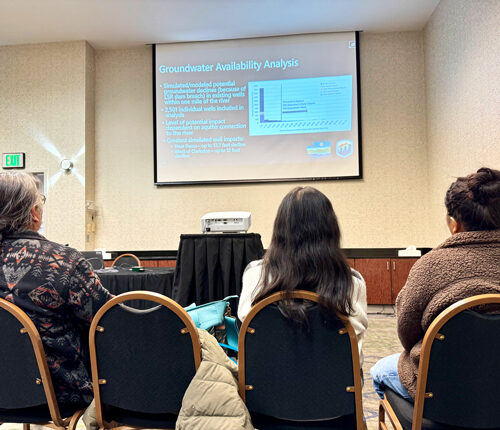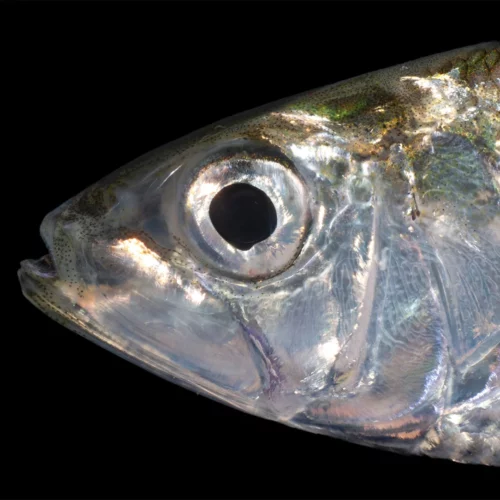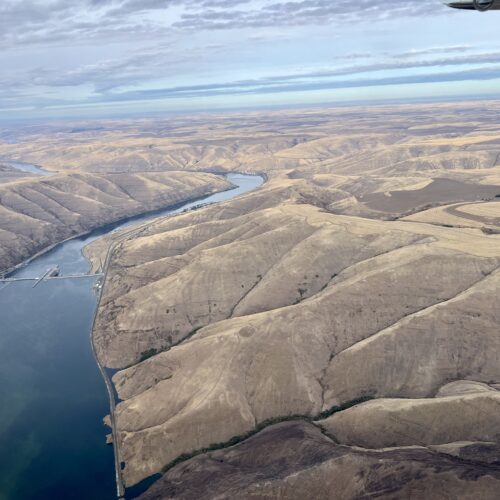Lamprey have been around for more than 450 million years before dinosaurs roamed the earth. The eel-like fish survived ice ages and heatwaves.
Now, they aren’t doing well, and scientists don’t know exactly why, but they do know lamprey have struggled getting around large concrete dams in the Pacific Northwest.
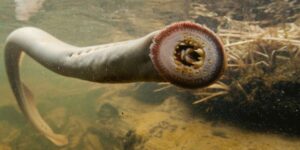
Adult Pacific lamprey CREDIT: Dave Herasimtschuk/ U.S. Fish And Wildlife Service
Not only are Pacific lamprey culturally important to Northwest tribes, they also are imperiled. In addition, young lamprey help filter river water as they feed on algae in the sediment. After adult lamprey die, their bodies provide key nutrients to river ecosystems.
Scientists know very little about the lamprey life cycle, including how young Pacific lamprey pass through dams.
“The more we can learn about lamprey as they’re passing through dams, that’s kind of the big black box right now,” said Bob Mueller, an earth scientist with Pacific Northwest National Laboratory.
However, that lack of knowledge could soon change with the innovation of tiny batteries that will allow scientists to track the young gray, toothy fish as they migrate to the ocean.
“This is the very first acoustic telemetry study with juvenile Pacific lamprey on the mainstem of the Columbia River System,” said Kate Deters, an earth scientist with the lab.
With this study, scientists hope to learn more about the behavior and survival of these young lamprey as they pass through dams on the Snake River.
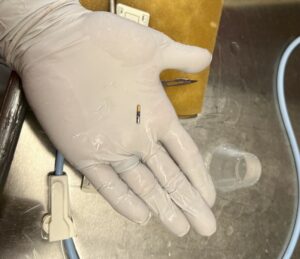
The lamprey tags are about the size of a long grain of rice. CREDIT: Courtney Flatt
“In the past, the tags just haven’t been small enough to tag in these very small fish,” she said.
In addition, this transmitter provides gobs of information about where each fish passes through the dams, from the spillway to bypass systems to through the turbines. Moreover, Deters said, scientists might learn more about where lamprey like to travel within the river, like how close they swim to the bank.
The tag that’s gathering this information is powered by a tiny battery, said Daniel Deng, a lab fellow. This microbattery took roughly three years to develop, building on years of earlier mircobattery work. The battery for these tags lasts about 30 days when the transmitter sends information every five seconds, Deng said. In that time, it will help gather invaluable information, he said. New designs scientists are working on should improve the battery life, Deng said.
“Hopefully, we can provide some good information for policymakers and other stakeholders, so they can use this information to have even better dam operations,” Deng said.
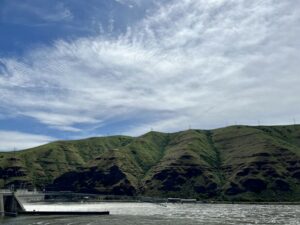
Lower Granite Dame CREDIT: Courtney Flatt
Hydropower dams on the Columbia River System have been fine-tuned for salmon, said Steve Juhnke, a fish biologist project manager with the U.S. Army Corps of Engineers. However, those fish passage have sometimes neglected other anadromous fish, such as lamprey, and resident fish, such as American shad, he said.
“It’s encouraging to get to the point where you can include those fish in your studies and consider them in the operations of the project,” Juhnke said.
Moreover, he said, lamprey are poor swimmers, which makes it a challenge for them to migrate downstream, as well as for adult fish to swim up ladders.
“There have been a lot of assumptions made about juvenile lamprey in the past, and now we’re able to either prove or disprove those assumptions,” Juhnke said.
One of those assumptions includes the water depths that lamprey migrate in the river, he said.
Information from this study will help the Army Corps improve lamprey passage if possible, he said. This pilot project cost around $1.1 million, he said. The Army Corps plans to fund this project for up to four more years, moving around to study different dams, he said, each of which have unique passage challenges.
At the juvenile fish facility at Lower Granite Dam on the shores of the Snake River, scientists set up a temporary lamprey triage in a small white trailer.
Earlier, workers at the facility, which is dubbed The Heartbeat of Lower Granite, caught young lamprey that were roughly the width of a pencil and up to 4 inches long.
The first time Deters collected lamprey, she said she held her breath.
At first, there weren’t a ton of lamprey, she said, but once all the water drained away she saw a lot more lamprey that hadn’t filtered through the sample tank.
With fish to tag, the study was a go, she said.
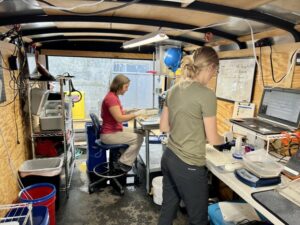
Scientists Jill Janak (right) and Kate Deters collect information and tag juvenile lamprey inside a trailer at Lower Granite Dam. CREDIT: Courtney Flatt
“The run is pretty variable. There won’t be any lamprey in a sample for a few days, and then all of the sudden, there might be a big pulse of fish. So, we just have to wait for the fish to come to us,” Deters said.
So far in their lives, these young lamprey have lived only in tributaries, a part of their life cycle scientists hope to learn more about, Deters said.
“We just don’t know a lot about them,” Deters said. “The fact that they are down in the sediment for five to seven years before they decide to migrate out, it’s just kind of mind-boggling.”
After that time in the sediment, the fish begin their journey out to sea, where they’ll fatten up, using sucker-like jaws to parasitically attach themselves to other sea-faring fish and whales. Lamprey will spend two to three years in the ocean, Mueller said.
To tag the young lamprey, Mueller first placed each fish into an anesthetic bath, which put the fish to sleep.
“There’s no gill movement. The fish is pretty much just still,” he said, of the anesthetized lamprey. “You don’t want to be trying to tag a fish when it’s still moving around. It usually doesn’t work out very well.”
Then, Jill Janak, a scientist at the lab, collected data on each fish, including its color and length. Each lamprey had to be at least 135-millimeters long.
“This one is just barely big enough to tag,” she said, as she placed the tiny lamprey alongside a ruler.
Finally, Deters placed a small tube with flowing water in the mouth of the lamprey. This helped the fish breathe, even though the whole procedure took less than 20 seconds.
“Every once in a while, I”ll get one that just decides to suck onto my finger, and it’s kinda cute,” she said.
Then, Deters used a sterilized surgical blade to make a small incision about a finger’s width below the lamprey’s gill pores. She placed the acoustic tag just below the fish’s skin into its body cavity. Deters then placed the lamprey in a bucket of river water to recover from the anesthesia.
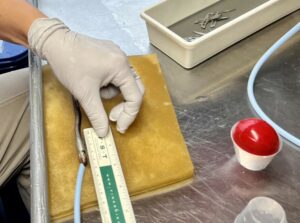
A small juvenile lamprey lays next to a ruler on a table. A blue tube is inserted in its mouth to give it water. Scientist Kate Deters Measures Where To Place The Tag Inside The Young Lamprey. CREDIT: Courtney Flatt
The surgical procedure was so quick and small that scientists didn’t need to suture the wounds, as they used to do with larger acoustic tags.
“This surgery is so much simpler than what we’ve done in the past with Chinook because the tag is so small,” Deters said.
With Chinook salmon, scientists used to suture the incision after they inserted the tags because the tags were so much larger.
The earlier surgeries and the fast 20-second procedure Deters performed could be the difference between in-patient and out-patient surgeries, Deng joked.
To get the tags and the insertion procedure just right, scientists at Pacific Northwest National Laboratory evaluated the health of tagged for around a month. They wanted to observe how well fish could swim with tags.
“We want to make sure that the tags and the tagging process do not affect the fish’s natural behavior or their response to physical stressors in the natural environment,” Deng said.
It’s been a long road studying these fish in the natural environment. For Northwest tribes, years of studying lamprey have helped shine a light on these culturally important fish, often called eels.
Lamprey are a first food, said Aaron Jackson, the lamprey project leader for the Confederated Tribes of the Umatilla Indian Reservation.
“Lampreys are, in my mind, the first food,” Jackson said. “I’ve had them grilled. I’ve had them smoked over cherry wood. I even have a friend who has made lamprey patee with them. That’s quite good.”
Jackson called lamprey a unique and acquired taste, with a high lipid content and lots of oil, similar to mackerel.
Indigenous people used to eat lamprey often for nourishment, he said. Now, the fish are far less abundant.
The Confederated Tribes of the Umatilla Indian Reservation now harvests mostly at Willamette Falls instead of all throughout its ceded lands in northeastern Oregon and southeastern Washington and at Celilo Falls, before the construction of The Dalles Dam flooded the historic fishing area and marketplace, Jackson said.

